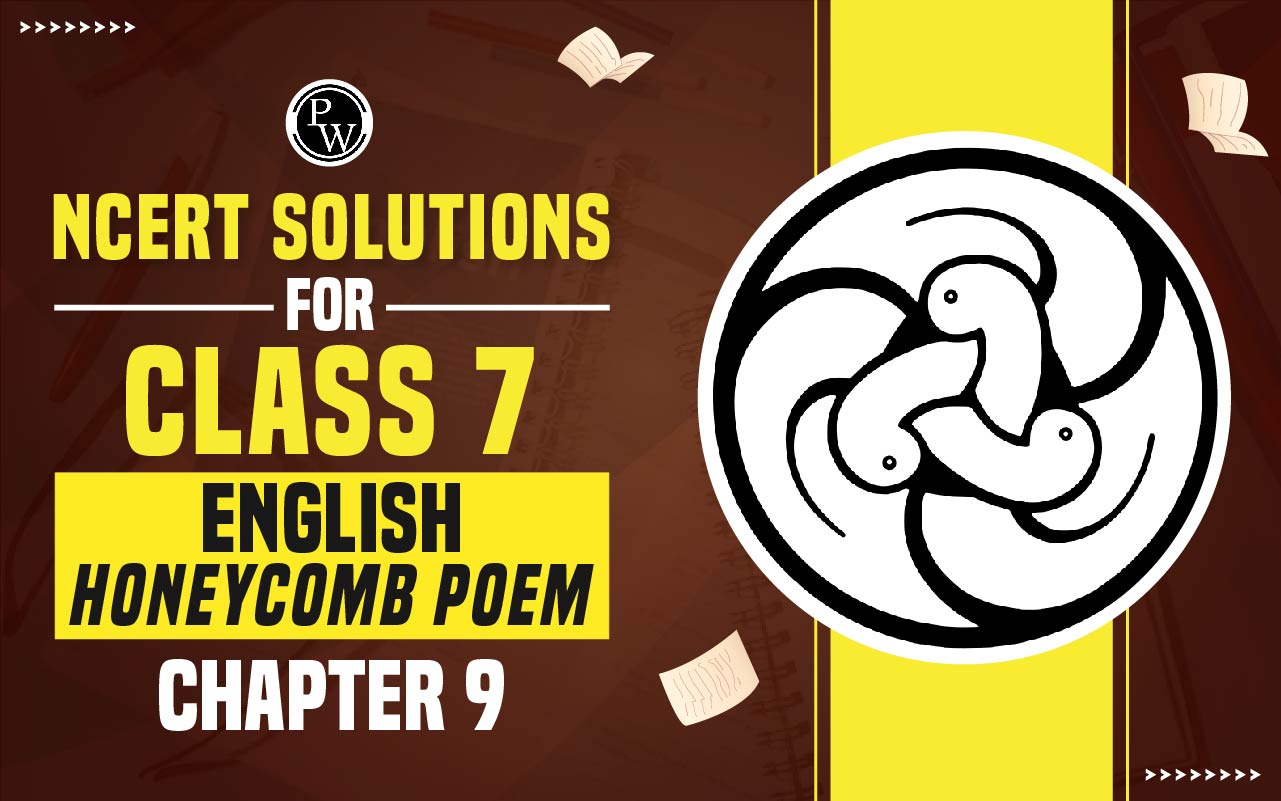

NCERT Solutions for Class 7 English Honeycomb Poem Chapter 9
NCERT Solutions Class 7 English Honeycomb Poem Chapter 9: At Physics Wallah, we provide accurate NCERT Solutions Class 7 English Honeycomb Poem Chapter 9 that addresses all questions from the Honeycomb textbook. Our NCERT Solutions for Class 7 are designed to adhere to the CBSE board standards. Our expert educators formulate these solutions to ensure students receive comprehensive assistance for every question in the book. "Garden Snake" is a brief poem in which the writer shares his apprehension of snakes. However, he also reveals that he isn't afraid of the garden snake. This highlights the innocence inherent in a child's perspective.NCERT Solutions for Class 7 English Honeycomb Poem Chapter 9 Garden Snake
NCERT Solutions Class 7 English Honeycomb Poem Chapter 9 Garden Snake is provided below for CBSE Class 7 students. Find all the solutions to chapter 9 on this page:Working with the Poem
Question 1. Answer the following questions:(i) Pick out the line that suggests that the child is afraid of snakes.
(ii) Which line shows a complete change of the child’s attitude towards snakes? Read it aloud.
(iii) “But mother says that kind is good…” What is mother referring to?
Answer: (i) The line that suggests that the child is afraid of snakes is: “I saw a snake and ran away…” (ii) The line that shows a complete change of child’s attitude towards snakes is: “I’ll stand aside and watch him pass,” (iii) The mother is referring to the “garden snakes”.Question 2: Find the word that refers to the snake’s movements in the grass.
Answer: “Wiggles” is the word that refers to the snake’s movements in the grass.Question 3: There are four pairs of rhyming words in the poem. Say them aloud.
Answer: The four pairs of rhyming words in the poem are: Away-say Good-food Grass-pass Mistake-snakeQuestion 4: A snake has no legs or feet, but it moves very fast. Can you guess how? Discuss in the group.
Answer: A snake wiggles, and that’s how it moves very fast, although it does not have legs or feet.
Question 5: Can you recall the word used for a cobra’s long sharp teeth? Where did you come across this word first?
Answer: The word used for cobra’s long sharp teeth is “fangs”. I heard this word while watching the Discovery channel.| CBSE Syllabus Class 7 | |
| CBSE Class 7 English Syllabus | CBSE Class 7 Math Syllabus |
| CBSE Class 7 Social Science Syllabus | CBSE Class 7 Science Syllabus |
NCERT Solutions for Class 7 English Honeycomb Poem Chapter 9 Important Questions
- Who is the poet of Unit 9 Poem of NCERT Solutions for Class 7 English, and what was his initial reaction to seeing a snake?
- What did the poet’s mother tell him regarding the snake in Unit 9 Poem of NCERT Solutions for Class 7 English?
- What thoughts can be drawn out about snakes from Unit 9 Poem of NCERT Solutions for Class 7 English?
CBSE Board Exam Centre List 2024
NCERT Solutions for Class 7 English Honeycomb Poem Chapter 9 Summary
"Garden Snake" is a poem penned by Muriel L. Sonne, highlighting that not all snakes are harmful. Before delving into the poem, Muriel poses a query, asking if you've ever witnessed a snake engaging in combat with a mongoose, burrowing into a hole, or swimming in a river. The poem unfolds with the poet recounting an encounter with a snake, prompting them to flee out of the belief that all snakes pose a threat. Seeking solace, the poet confides in their mother about the incident. In response, the mother reassures the child that not all snakes are dangerous, particularly the kind found in gardens, which primarily feed on insects. Encouraged by this insight, the poet observes a similar snake in the garden without fear, understanding it to be harmless. For comprehensive solutions to question papers and integrated grammar, Physics Wallah offers accessible resources free of charge. The poem's simple language facilitates a clear understanding for students, aiding in comprehension. Questions and uncertainties regarding the poem can be resolved by accessing NCERT Solutions for Class 7 English Honeycomb Chapter "Garden Snake" on Physics Wallah.NCERT Solutions for Class 7 English Honeycomb Poem Chapter 9 PDF Download
How to Prepare with NCERT Solutions for Class 7 English Honeycomb Poem Chapter 9
Preparing with NCERT Solutions for Class 7 English Honeycomb Poem Chapter 9 involves a structured approach to understanding the poem, analysing its themes, literary devices, and language. Here's a detailed guide on how to prepare effectively: Understanding the Poem- Read the Poem Thoroughly: Begin by reading the poem attentively, understanding its literal meaning, and identifying the central theme or message.
- Analyse the Title: Reflect on the significance of the title and how it relates to the content of the poem.
- Identify Characters and Setting: Note down any characters mentioned and the setting of the poem. Consider how these elements contribute to the overall mood or tone.
- Identify Poetic Devices: Look for poetic devices such as metaphors, similes, personification, imagery, etc. These devices enhance the poetic expression and contribute to the overall impact of the poem.
- Analyze Structure and Form: Consider the structure of the poem (e.g., rhyme scheme, stanzaic form) and how it influences the reading experience.
- Language Analysis: Pay attention to the language used by the poet. Analyse word choice, symbolism, and any recurring motifs.
- Identify Themes: Explore the central themes addressed in the poem. These could include love, nature, loss, identity, etc.
- Support with Evidence: Gather textual evidence (lines or phrases) to support your interpretation of the themes. This strengthens your understanding and analysis.
- Refer to NCERT Solutions: Utilise NCERT Solutions for Class 7 English Honeycomb Poem Chapter 9 to clarify doubts and gain insights into the poem.
- Solve Questions: Practise solving the questions provided in the NCERT Solutions. This helps in reinforcing your understanding of the poem and its nuances.
- Compare Interpretations: Consider different interpretations of the poem by scholars or classmates. Engage in discussions to broaden your perspective.
- Evaluate the Effectiveness: Reflect on the effectiveness of the poet's techniques in conveying the message or theme of the poem. Analyse how well the poet engages the reader and evokes emotions.
- Write Summaries and Analyses: Practise writing summaries and analyses of the poem. This improves your ability to articulate your understanding coherently.
- Compose Responses: Write responses to essay-type questions based on the poem. Support your arguments with evidence from the text.
- Regular Revision: Review the poem periodically to reinforce your understanding and retain key concepts.
- Self-Assessment: Test your knowledge by attempting quizzes or self-assessment exercises related to the poem.
- Supplementary Readings: Explore additional readings or related poems to deepen your understanding of similar themes or literary techniques.
- Online Forums or Discussions: Participate in online forums or discussions where you can exchange ideas and perspectives with others studying the same poem.
Benefits of NCERT Solutions for Class 7 English Honeycomb Poem Chapter 9
NCERT Solutions for Class 7 English Honeycomb Poem Chapter 9 can offer numerous benefits to students. This chapter typically covers a poem or a set of poems, focusing on themes, literary devices, and poetic elements. Here's a detailed look at the benefits students can gain from using these solutions:- Understanding Poetry : Poetry can sometimes be challenging for students due to its figurative language and symbolism. NCERT Solutions provide explanations and interpretations of the poems featured in Class 7 English Honeycomb. This helps students comprehend the deeper meanings behind the verses, enhancing their ability to analyse and appreciate poetry.
- Clarification of Concepts : NCERT Solutions clarify any doubts or confusion students may have regarding poetic elements such as rhyme, metre, imagery, metaphor, simile, personification, etc. By understanding these concepts, students can better grasp the structure and meaning of the poems they encounter, thus improving their overall comprehension of literature.
- Language Enhancement : Through the analysis of poems and the explanations provided in the solutions, students can enrich their vocabulary and language skills. They learn new words, phrases, and idiomatic expressions used in poetic contexts, which can enhance their writing and communication skills across various subjects.
- Literary Analysis Skills : The NCERT Solutions encourage students to critically analyse the poems by examining themes, tone, mood, and literary devices employed by the poets. This fosters their ability to think critically and develop analytical skills necessary for understanding not only poetry but also other forms of literature.
- Cultural and Historical Context : Many poems are influenced by the cultural and historical contexts in which they were written. NCERT Solutions often provide insights into these contexts, helping students understand how societal norms, events, and beliefs shape literature. This broadens students' perspectives and fosters an appreciation for the cultural diversity reflected in poetry.
- Exam Preparation : NCERT Solutions are designed to align with the curriculum prescribed by educational boards, making them invaluable resources for exam preparation. By practising questions and answers provided in the solutions, students can familiarise themselves with the pattern of questions asked in exams and develop effective strategies for answering them.
- Self-Assessment and Improvement : NCERT Solutions typically include exercises, questions, and activities that allow students to test their understanding of the poems independently. By attempting these exercises and comparing their answers with the solutions provided, students can identify areas of weakness and focus on improving them. This promotes self-assessment and facilitates continuous learning.
- Encourages Creativity : Studying poetry can inspire creativity and imagination in students. By engaging with the poems featured in Class 7 English Honeycomb, students may be encouraged to write their own poetry, exploring their thoughts, emotions, and observations through creative expression.
NCERT Solutions for Class 7 English Honeycomb Poem Chapter 9 FAQs
What is the tone of the poem?
How can I write a summary of the poem?
What is the historical context of the poem?
Are there any critical analyses of the poem available?
How can I relate the poem to real-life experiences?











